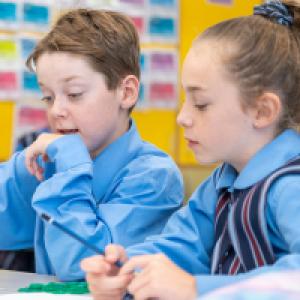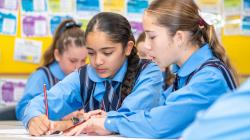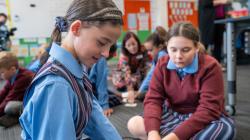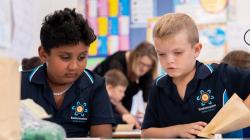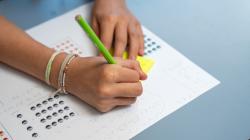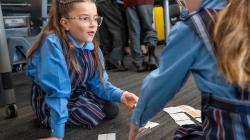'Multiplication: Trays of arrays' is one of our new teaching sequences for V9
- On the 'In this sequence' tab you'll find all the tasks in this sequence, a suggested implementation plan and curriculum alignment.
- The 'Behind this sequence' tab shows how key mathematical ideas develop over the sequence.
- Have you taught this sequence? Use the Feedback button to let us know how it went!
Tasks in this sequence
Task 1 • How many cupcakes?
Students learn that an array can be partitioned into smaller arrays to help work out how many there are altogether.
Task 2 • How many bread rolls?
Students learn that factors can be partitioned and distributed to make partial products in multiplication.
Task 3 • How can I work it out?
Students build their understanding of the distributive property.
Task 4 • Packing rolls
Students learn that when multiplying two numbers, halving one number and doubling the other does not change the product.
Task 5 • Packing cakes
Students learn that when multiplying a set of numbers, the product is the same no matter how the numbers are grouped.
Task 6 • Transforming arrays
Students complete an activity with arrays to build their understanding of the associative property.
Task 7 • Card sort
Students complete a card sort activity to consolidate their understanding of the distributive and associative properties of multiplication.
Suggested implementation
This time plan is just one way that you might choose to implement this sequence. We have used a warm-up activity at the start of most lessons, and a number of tasks are split across two lessons. The timing provided in the tasks’ documentation align with this implementation advice.
This time plan is just one way that you might choose to implement this sequence. We have based this plan on 50-minute lessons, with some tasks split across two lessons. The timing provided in the tasks’ documentation align with this implementation advice.
| Week 1 | Week 2 | |
|---|---|---|
| Monday | Task 1 • How many cupcakes?
| Task 4 • Packing rolls
|
| Tuesday | Task 1 • How many cupcakes?
| Task 5 • Packing cakes
|
| Wednesday | Task 2 • How many bread rolls?
| Task 6 • Transforming arrays
|
| Thursday | Task 3 • How can I work it out?
| Task 6 • Transforming arrays
Task 7 • Card sort
|
| Friday | Task 3 • How can I work it out?
| Task 7 • Card sort
|
Curriculum and syllabus alignment
Achievement standards
Students use their proficiency with addition and multiplication facts to add and subtract, multiply and divide numbers efficiently.
Australian Curriculum V9 alignment
Number
Develop efficient strategies and use appropriate digital tools for solving problems involving addition and subtraction, and multiplication and division where there is no remainder
Algebra
Recall and demonstrate proficiency with multiplication facts up to 10 x 10 and related division facts; extend and apply facts to develop efficient mental strategies for computation with larger numbers without a calculator
The array is a powerful representation of multiplication. It clearly demonstrates the relationship between three aspects of multiplication: the whole (product), the number of rows (first factor), and the number in each row (second factor). The array also demonstrates multiplicative properties. This sequence uses the array to explore the distributive and associative properties of multiplication.
The distributive property: When students partition larger arrays into groups, as smaller arrays, and recombine these, they are exposed to the distributive property of number, which promotes a more connected understanding of multiplicative structures (Young-Loveridge 2005; Siemon & Breed, 2006). For example, a 7 x 8 array can be split into two smaller arrays of 5 x 8 and 2 x 8. If 7 x 8 is not a known fact, it is easy to work out the partial products of each of these smaller arrays and add them together to find the whole product.
The associative property: Students experience the associative property when they use doubling, halving and generate equivalent expressions using related factors. Equivalence between related facts can be represented by physically transforming the array. For example, a 6 x 8 array can be halved by dividing the array into two 6 x 4 arrays. These two arrays can then be combined to create a 4 x 12 array, illustrating the equivalence between the two facts.
Sequence Framework
This Sequence Framework presents an overview of the key elements in this sequence.
| Learning goals | Students’ mathematical activity | Representation | Context | |
| Task 1 | An array can be partitioned to form smaller arrays. Adding the products of the smaller arrays together gives the total in the original array. | Students use different strategies to calculate the number of cupcakes in a 6 x 15 array. | A 6 x 15 array of bread rolls. 6 x 15 can be seen two different ways: 6 smaller arrays of 15 cakes and a large array of cakes arranged in 6 rows of 15. | Working out the total number of cupcakes on display in the reSolve Bakery. |
| Task 2 | In multiplication, factors can be partitioned and distributed to make partial products. Partitioning factors to create well-known facts, such as tens, is particularly helpful. The partial products are then added together to find the product of the original multiplication. This property is known as the distributive property of multiplication. | Students partition factors in different ways to calculate the number of bread rolls in a 4 x 24 array. They use mathematical reasoning to explain which strategy they believe is most useful. | A 4 x 24 array of cakes. 4 x 24 can be seen two different ways: 4 smaller arrays of 24 bread rolls and a large array of bread rolls arranged in 4 rows of 24. | Working out the total number of bread rolls on display in the reSolve Bakery. |
| Task 3 | In multiplication, factors can be partitioned and distributed to make partial products. Partitioning factors to create well-known facts, such as tens, is particularly helpful. The partial products are then added together to find the product of the original multiplication. This property is known as the distributive property of multiplication. | Students partition factors in different ways to calculate the number of bread rolls in a 4 x 24 array. They use mathematical reasoning to explain which strategy they believe is most useful | Students use the array to represent their strategies. | An activity in which students apply the distributive property of multiplication to solve problems. |
| Task 4 | Halving one number in a multiplication means we need to double the other number to ensure the total remains the same. Equivalence in multiplication is maintained no matter how the numbers are grouped. | Students calculate how many bags of 6 bread rolls can be made from 5 trays of 12 bread rolls. | There are 5 trays of 12 bread rolls with the rolls arranged in a 4 x 3 array. The 12 rolls on one tray can be divided easily into 2 groups of 6. | Packing trays of 12 bread rolls into bags of 6 in the reSolve Bakery. |
| Task 5 | Dividing one number by 4 in a multiplication means we need to multiply the other number by 4 to ensure the total remains the same. Equivalence in multiplication is maintained no matter how the numbers are grouped. | Students calculate how many boxes of 6 cupcakes can be made from 3 trays of 24 bread rolls. | There are 3 trays of 24 cupcakes with the cakes arranged in a 4 x 6 array. The 24 cakes on one tray can be divided easily into 4 groups of 6. | Packing trays of 24 cupcakes into boxes of 6 in the reSolve Bakery. |
| Task 6 | Equivalence in multiplication is maintained no matter how the numbers are grouped. This property is known as the associative property of multiplication. | Students partition and rearrange arrays to show how different multiplication facts are equivalent. | Students create and use arrays to show how different multiplication facts are equivalent. | An activity in which students apply the associative property of multiplication to solve problems. |
| Task 7 | In multiplication, factors can be partitioned and distributed to make partial products. The partial products are then added together to find the product of the original multiplication (distributive property). Equivalence in multiplication is maintained no matter how the numbers are grouped (associative property). | Students apply their learning from the sequence in a card sort activity. They are asked to match different equations used to solve multiplication problems with corresponding arrays. | Students make connections between two different representations: arrays and equations. | An activity in which students apply the distributive and associative properties of multiplication to solve problems. |
